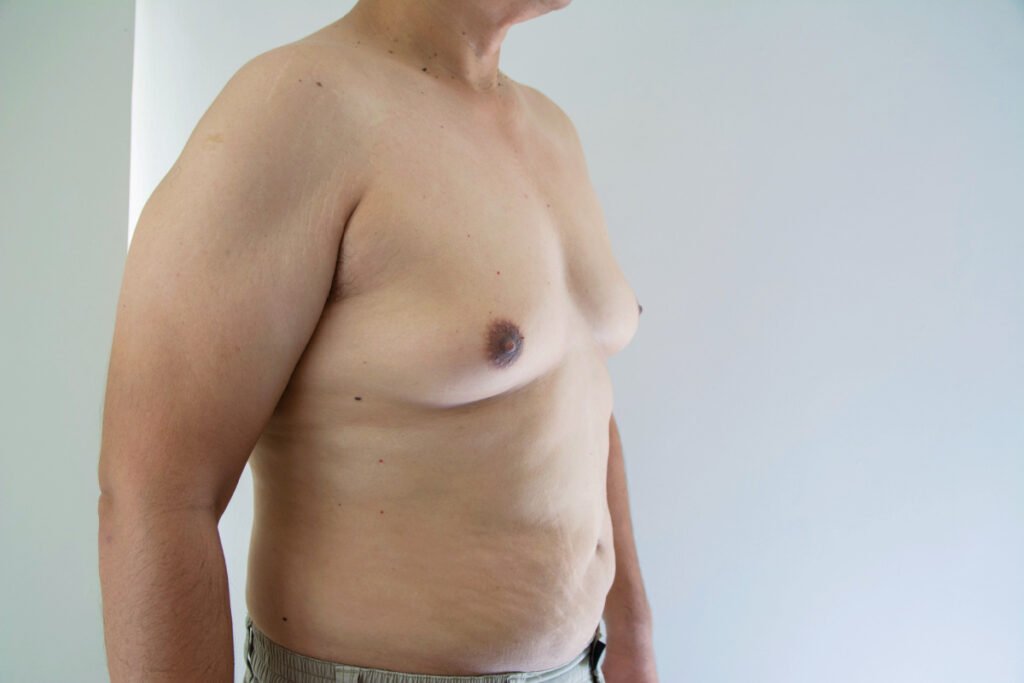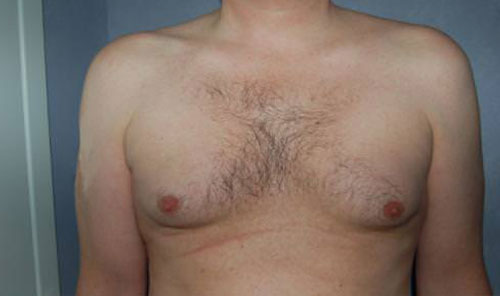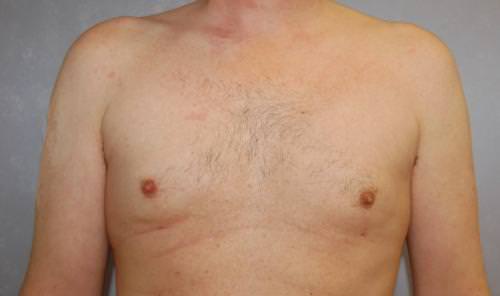Are My Male Breasts Fat or Gynecomastia?

If you are one of the many men who have enlarged breasts (“man boobs”), you may be wondering if you have a condition that is preventing you from having a masculine-looking chest. The key to determining an accurate diagnosis of either pseudogynecomastia (excess chest fat) or true gynecomastia (which involves the glands) is identifying the type of tissue that is causing the enlarged breasts. Here, Cincinnati plastic surgeon Dr. Mark Mandell-Brown explains both of these bothersome conditions and how they can be treated with male breast reduction.
What is pseudogynecomastia?
Pseudogynecomastia is an increased amount of excess adipose tissue (fat) in male breasts—which typically accumulates around, behind, or under the nipple. Excess breast fat accumulation can occur with age or weight gain and will feel soft and pliable to the touch. The term “pseudo” means false but even “false gynecomastia” presents real physical and psychological issues for men.
What is gynecomastia?
Gynecomastia is an overabundance of breast gland tissue present in males. It can affect one or both breasts, sometimes disproportionately, and will have a firmer feel than an accumulation of fat alone. Affecting over half of all men in the U.S., excess breast tissue is often noticed in adolescence; it can disappear after puberty or persist into adulthood. Gynecomastia isn’t usually a medical issue but it can deeply impact the self-perception and lifestyle of affected men.
“Dr. Mandell-Brown is a true consummate caring professional. He is conservative and did not try to push me into some expensive procedure I did not need. He explained everything in detail. His staff of ladies are charming and welcoming and are all so lovely. It’s a fun experience. We are so lucky to have a plastic surgeon like Dr. Mandell-Brown right here in Cincinnati.”
—5-star Google review from a male patient
Causes of gynecomastia
Most men with gynecomastia are unable to pinpoint the cause of their condition but causes of gynecomastia include:
- Hormonal imbalances
- Steroids
- Weight gain
- Certain prescription medications
- Certain health conditions
- Substance use (recreational drugs and/or alcohol)
Signs and symptoms of gynecomastia
Having a female-like chest appearance is usually the primary sign and concern of men with gynecomastia. Symptoms beyond decreased confidence are rarely reported, but may include:
- Breast tissue that feels swollen
- Breast pain or tenderness
- Nipple sensitivity or chafing against clothing
This patient underwent male breast reduction to remove excess fat and tissue that added fullness to his chest area. In the After photo on the right, you can see how much flatter and firmer his chest appears post-surgery.
*Individual results may vary.
Treating pseudogynecomastia
In cases of pseudogynecomastia, targeted exercises and weight loss may help reduce the fat that has built up around and behind the areolas—though many men find it challenging to tone this area once the fat has developed. Typically, pseudogynecomastia is treated with Cincinnati male breast reduction techniques such as liposuction to carefully remove the fat and sculpt a more masculine chest contour. Depending on your unique anatomy, we may also remove breast tissue for stronger results.
Treating gynecomastia
Gynecomastia requires more comprehensive male breast reduction techniques, including direct surgical excision of the breast tissue and liposuction to remove excess fat to achieve a natural-looking, masculine physique.
Cosmetic surgery to treat male breasts is typically required because gynecomastia is often genetic and there is little you can do to prevent or correct it. That said, avoiding behaviors that may exacerbate your condition, such as taking androgenic steroids or using recreational drugs, may help reduce the effects of gynecomastia.
While surgery is usually the best solution, before planning any intervention for gynecomastia, we will have your hormone levels tested. This allows for diagnosis and correction of any possible underlying causes for the sake of your health; it will also help reduce the risk of re-developing gynecomastia and thereby diminishing your cosmetic surgery results.
Male breast reduction in CincinnatiIf you have enlarged male breasts, our surgeons can help you understand the nature of your condition and develop a treatment plan to sculpt a more masculine chest. We perform male breast reduction procedures in our private, fully accredited surgery center for your safety and comfort.
To learn more, we invite you to schedule a consultation at the Mandell-Brown Plastic Surgery Center by calling (513) 984-4700. We proudly serve the greater Cincinnati, Dayton, and Springboro areas and regularly welcome out-of-town patients to our practice.
References »
Cuhaci N, Polat SB, Evranos B, Ersoy R, Cakir B. Gynecomastia: Clinical evaluation and management. Indian Journal of Endocrinology and Metabolism. 2014 Mar;18(2):150-8. doi: 10.4103/2230-8210.129104.
Venkata Ratnam B. How important is “pseudogynecomastia”? Aesthetic Plastic Surgery. 2011 Aug;35(4):668-9. doi: 10.1007/s00266-010-9629-0.

